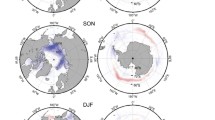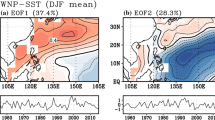Abstract
We investigate the spatio-temporal characteristics of the austral spring Ross Ice Shelf Polynya (RISP) and its relationship with atmospheric circulation anomalies based on the sea ice concentration data from the National Snow and Ice Data Center (NSIDC) and the ERA5 reanalysis data. The RISP area series is derived by choosing 25% sea ice concentration as the threshold. Then the principal spatial patterns of the RISP are acquired by using the empirical orthogonal function (EOF) analysis. The leading EOF (EOF1) has a spatial distribution of a strong negative core in the northeastern RISP with a weak positive core near the Cape Adare, explaining 48.1% of the variance. This mode matches the wind pattern of the northwesterly on the western Ross Sea while southwesterly on the eastern Ross Sea, which reflects the zonal variation of the RISP. There is also a strong positive correlation between the RISP area and the PC1. The EOF2 explains 27.4% of the variance, and is mainly characterized by a large region of low values in the northwestern Ross Sea with a small region of high value near Cape Colbeck. Matching the strong southerly over the western Ross Sea, the EOF2 partly depicts the meridional variation of the RISP. We further explored the connections between the RISP and sea level pressure, and found that a deeper and more eastward Amundsen Sea Low (ASL) in November often coincides with a larger and more eastward RISP in December. This lagged response is partly generated through the influence of the ASL on the RISP in November.










Similar content being viewed by others
References
Ainley DG, Clarke ED, Arrigo K, Fraser WR, Kato A, Barton KJ, Wilson PR (2005) Decadal-scale changes in the climate and biota of the Pacific sector of the Southern Ocean, 1950s to the 1990s. Antarct Sci 17(2):171–182. https://doi.org/10.1017/S0954102005002567
Alkama R, Koffi EN, Vavrus SJ, Diehl T, Francis JA, Stroeve J, Forzieri G, Vihma T, Cescatti A (2020) Wind amplifies the polar sea ice retreat. Environ Res Lett 15(12):124022. https://doi.org/10.1088/1748-9326/abc379
Arrigo KR, van Dijken GL (2003) Phytoplankton dynamics within 37 Antarctic coastal polynya systems. J Geophys Res. https://doi.org/10.1029/2002JC001739
Arrigo KR, van Dijken GL (2004) Annual changes in sea-ice, chlorophyll a, and primary production in the Ross Sea, Antarctica. Deep Sea Res II Top Stud Oceanogr 51(1–3):117–138. https://doi.org/10.1016/j.dsr2.2003.04.003
Bromwich DH, Kurtz DD (1984) Katabatic wind forcing of the Terra Nova Bay polynya. J Geophys Res 89(C3):3561. https://doi.org/10.1029/JC089iC03p03561
Bromwich DH, Liu Z, Rogers AN, Van Woert ML (1998) Winter atmospheric forcing of the Ross Sea Polynya. In: Jacobs SS, Weiss FF (eds) Ocean, ice, atmosphere: interactions at the Antarctic continental margin. American Geophysical Union, Washington, DC, pp 101–133. https://doi.org/10.1029/AR075p0101
Coggins JHJ, McDonald AJ (2015) The influence of the Amundsen Sea Low on the winds in the Ross Sea and surroundings: insights from a synoptic climatology. J Geophys Res Atmos 120(6):2167–2189. https://doi.org/10.1002/2014JD022830
Comiso JC, Kwok R, Martin S, Gordon AL (2011) Variability and trends in sea ice extent and ice production in the Ross Sea. J Geophys Res 116:C04021. https://doi.org/10.1029/2010JC006391
De Pace L, Smith M, Thomson J, Stammerjohn S, Ackley S, Loose B (2019) Frazil ice growth and production during katabatic wind events in the Ross Sea, Antarctica. Cryosphere. https://doi.org/10.5194/tc-2019-213
Dee DP, Uppala SM, Simmons AJ, Berrisford P, Poli P, Kobayashi S, Andrae U, Balmaseda MA, Balsamo G, Bauer P, Bechtold P, Beljaars ACM, van de Berg L, Bidlot J, Bormann N, Delsol C, Dragani R, Fuentes M, Geer AJ, Haimberger L, Healy SB, Hersbach H, Hólm EV, Isaksen L, Kållberg P, Köhler M, Matricardi M, McNally AP, Monge-Sanz BM, Morcrette JJ, Park BK, Peubey C, de Rosnay P, Tavolato C, Thépaut JN, Vitart F (2011) The ERA-Interim reanalysis: configuration and performance of the data assimilation system. Q J R Meteorol Soc 137(656):553–597. https://doi.org/10.1002/qj.828
Ding Y, Cheng X, Li X, Shokr M, Yuan J, Yang Q, Hui F (2020) Specific relationship between the surface air temperature and the area of the Terra Nova Bay Polynya, Antarctica. Adv Atmos Sci 37(5):532–544. https://doi.org/10.1007/s00376-020-9146-2
Drucker R, Martin S, Kwok R (2011) Sea ice production and export from coastal polynyas in the Weddell and Ross Seas. Geophys Res Lett 38:L17502. https://doi.org/10.1029/2011GL048668
DuVivier AK, Cassano JJ (2015) Exploration of turbulent heat fluxes and wind stress curl in WRF and ERA-Interim during wintertime mesoscale wind events around southeastern Greenland. J Geophys Res Atmos 120(9):3593–3609. https://doi.org/10.1002/2014JD022991
Fichefet T, Goosse H (1999) A numerical investigation of the spring Ross Sea polynya. Geophys Res Lett 26(8):1015–1018. https://doi.org/10.1029/1999GL900159
Fogt RL, Wovrosh AJ, Langen RA, Simmonds I (2012) The characteristic variability and connection to the underlying synoptic activity of the Amundsen-Bellingshausen Seas Low. J Geophys Res 117:D07111. https://doi.org/10.1029/2011JD017337
Francis D, Eayrs C, Cuesta J, Holland D (2019) Polar cyclones at the origin of the reoccurrence of the Maud Rise Polynya in Austral winter 2017. J Geophys Res Atmos 124(10):5251–5267. https://doi.org/10.1029/2019JD030618
Gerringa LJA, Laan P, van Dijken GL, van Haren H, De Baar HJW, Arrigo KR, Alderkamp AC (2015) Sources of iron in the Ross Sea Polynya in early summer. Mar Chem 177:447–459. https://doi.org/10.1016/j.marchem.2015.06.002
Hersbach H, Bell B, Berrisford P, Hirahara S, Horányi A, Muñoz Sabater J, Nicolas J, Peubey C, Radu R, Schepers D, Simmons A, Soci C, Abdalla S, Abellan X, Balsamo G, Bechtold P, Biavati G, Bidlot J, Bonavita M, Chiara G, Dahlgren P, Dee D, Diamantakis M, Dragani R, Flemming J, Forbes R, Fuentes M, Geer A, Haimberger L, Healy S, Hogan RJ, Hólm E, Janisková M, Keeley S, Laloyaux P, Lopez P, Lupu C, Radnoti G, Rosnay P, Rozum I, Vamborg F, Villaume S, Thépaut JN (2020) The ERA5 global reanalysis. Q J R Meteorol Soc 146(730):1999–2049. https://doi.org/10.1002/qj.3803
Hillebrand FL, Bremer UF, Arigony-Neto J, da Rosa CN, MendesC W, Costi J, de Freitas MWD, Schardong F (2020) Comparison between atmospheric reanalysis models ERA5and ERA-Interim at the North Antarctic Peninsula region. Ann Am Assoc Geogr. https://doi.org/10.1080/24694452.2020.1807308
Holland MM, Landrum L, Raphael M, Stammerjohn S (2017) Springtime winds drive Ross Sea ice variability and change in the following autumn. Nat Commun 8(1):731. https://doi.org/10.1038/s41467-017-00820-0
Holland MM, Landrum L, Raphael MN, Kwok R (2018) The regional, seasonal, and lagged influence of the Amundsen Sea Low on Antarctic sea ice. Geophys Res Lett 45:4511227–4511234. https://doi.org/10.1029/2018GL080140
Hosking JS, Orr A, Marshall GJ, Turner J, Phillips T (2013) The influence of the Amundsen-Bellingshausen Seas Low on the climate of West Antarctica and its representation in coupled climate model simulations. J Clim 26:6633–6648. https://doi.org/10.1175/JCLI-D-12-00813.1
Hosking JS, Orr A, Bracegirdle TJ, Turner J (2016) Future circulation changes off West Antarctica: sensitivity of the Amundsen Sea Low to projected anthropogenic forcing. Geophys Res Lett 43:367–376. https://doi.org/10.1002/2015GL067143
Jakobson L, Vihma T, Jakobson E (2019) Relationships between sea ice concentration and wind speed over the Arctic Ocean during 1979–2015. J Clim 32:7783–7796. https://doi.org/10.1175/JCLI-D-19-0271.1
Kashiwase H, Ohshima KI, Nihashi S, Eicken H (2017) Evidence for ice-ocean albedo feedback in the Arctic Ocean shifting to a seasonal ice zone. Sci Rep 7:1–10. https://doi.org/10.1038/s41598-017-08467-z
Leppäranta M (2011) The drift of sea ice. Springer, Heidelberg
Li Y, Ji R, Jenouvrier S, Jin M, Stroeve J (2016) Synchronicity between ice retreat and phytoplankton bloom in circum-Antarctic polynyas. Geophys Res Lett 43:2086–2093. https://doi.org/10.1002/2016GL067937
Montes-Hugo MA, Yuan X (2012) Climate patterns and phytoplankton dynamics in Antarctic latent heat polynyas. J Geophys Res 117:C05031. https://doi.org/10.1029/2010JC006597
Nakata K, Ohshima KI, Nihashi S, Kimura N, Tamura T (2015) Variability and ice production budget in the Ross Ice Shelf Polynya based on a simplified polynya model and satellite observations. J Geophys Res Oceans 120:6234–6252. https://doi.org/10.1002/2015JC010894
Nigro MA, Cassano JJ (2014) Analysis of the Ross Ice Shelf airstream forcing mechanisms using self-organizing maps. Mon Weather Rev 142(12):4719–4734. https://doi.org/10.1175/MWR-D-14-00077.1
Parish TR, Bromwich DH (1989) Instrumented aircraft observations of the katabatic wind regime near Terra Nova Bay. Mon Weather Rev 117(7):1570–1585. https://doi.org/10.1175/1520-0493(1989)117%3c1570:IAOOTK%3e2.0.CO;2
Park J, Kim H, Jo Y, Kidwell A, Hwang J (2018) Multi-temporal variation of the Ross Sea Polynya in response to climate forcings. Polar Res 37:1444891. https://doi.org/10.1080/17518369.2018.1444891
Raphael MN, Holland MM, Landrum L, Hobbs WR (2019) Links between the Amundsen Sea Low and sea ice in the Ross Sea: seasonal and interannual relationships. Clim Dyn 52:2333–2349. https://doi.org/10.1007/s00382-018-4258-4
Reddy TE, Arrigo KR, Holland DM (2007) The role of thermal and mechanical processes in the formation of the Ross Sea summer polynya. J Geophys Res 112:C07027. https://doi.org/10.1029/2006JC003874
Robinson NJ, Williams MJM (2012) Iceberg-induced changes to polynya operation and regional oceanography in the southern Ross Sea, Antarctica, from in situ observations. Antarct Sci 24:514–526. https://doi.org/10.1017/S0954102012000296
Screen JA, Simmonds I (2010) The central role of diminishing sea ice in recent Arctic temperature amplification. Nature 464:1334–1337. https://doi.org/10.1038/nature09051
Silber I, Verlinde J, Wang S, Bromwich DH, Fridlind AM, Cadeddu M, Eloranta EW, Flynn CJ (2019) Cloud influence on ERA5 and AMPS surface downwelling longwave radiation biases in west Antarctica. J Clim 32:7935–7949. https://doi.org/10.1175/JCLI-D-19-0149.1
Smith SD, Muench RD, Pease CH (1990) Polynyas and leads: an overview of physical processes and environment. J Geophys Res Oceans 95:9461–9479. https://doi.org/10.1029/JC095iC06p09461
Tetzner D, Thomas E, Allen C (2019) A validation of ERA5 reanalysis data in the Southern Antarctic peninsula – Ellsworth Land region, and its implications for ice core studies. Geosciences. https://doi.org/10.3390/geosciences9070289
Turner J, Phillips T, Hosking JS, Marshall GJ, Orr A (2013) The Amundsen Sea low. Int J Climatol 33(7):1818–1829. https://doi.org/10.1002/joc.3558
Turner J, Hosking JS, Marshall GJ, Phillips T, Bracegirdle TJ (2016) Antarctic sea ice increase consistent with intrinsic variability of the Amundsen Sea Low. Clim Dyn 46:2391–2402. https://doi.org/10.1007/s00382-015-2708-9
Wenta M, Cassano JJ (2020) The Atmospheric boundary layer and surface conditions during katabatic wind events over the Terra Nova Bay Polynya. Remote Sens 12(24):4160. https://doi.org/10.3390/rs12244160
Yang L, Sun L, Emslie SD, Xie Z, Huang T, Gao Y, Yang W, Chu Z, Wang Y (2018) Oceanographic mechanisms and penguin population increases during the Little Ice Age in the southern Ross Sea, Antarctica. Earth Planet Sci Lett 481:136–142. https://doi.org/10.1016/j.epsl.2017.10.027
Zhang J, Stegall ST, Zhang X (2018) Wind-sea surface temperature-sea ice relationship in the Chukchi-Beaufort Seas during autumn. Environ Res Lett 13:34008. https://doi.org/10.1088/1748-9326/aa9adb
Acknowledgements
This study was supported by the National Natural Science Foundation of China (Grant No. 41941008). Data used in this study can be downloaded online (NSIDC: https://nsidc.org/data/G02202/versions/3; ERA5: https://cds.climate.copernicus.eu/cdsapp#!/dataset/reanalysis-era5-single-levels-monthly-means?tab=form). We are grateful to J. Scott Hosking for making the ASL indices data available (ASL indices: https://scotthosking.com/asl_index).
Author information
Authors and Affiliations
Corresponding author
Ethics declarations
Conflict of interest
The authors declare to have no conflict of interest.
Additional information
Publisher's Note
Springer Nature remains neutral with regard to jurisdictional claims in published maps and institutional affiliations.
Rights and permissions
About this article
Cite this article
Wang, T., Wei, H. & Xiao, J. Dynamic linkage between the interannual variability of the spring Ross Ice Shelf Polynya and the atmospheric circulation anomalies. Clim Dyn 58, 831–840 (2022). https://doi.org/10.1007/s00382-021-05936-0
Received:
Accepted:
Published:
Issue Date:
DOI: https://doi.org/10.1007/s00382-021-05936-0




